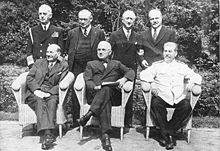William Daniel Leahy



William Daniel Leahy (born May 6, 1875 in Hampton , Franklin County , Iowa , † July 20, 1959 in Bethesda , Maryland ) was an American officer and the first fleet admiral in the United States Navy .
biography
family
Leahy comes from an Irish-American family. He was the son of Michael Arthur Leahy (1838–1921), a successful lawyer and Civil War veteran. As a child, moved to Ashland , Wisconsin with parents .
In 1904 he married Louise Tennent Harrington (? - 1942); both had children, u. a. the son William Harrington Leahy (1904-1986), the Rear Admiral.
Military service and diplomat
After his basic school education Leahy tried to be accepted at the United States Military Academy at West Point , but failed. So he attended high school in Ashland and was then able to get a scholarship to the United States Naval Academy in Annapolis , from which he graduated in 1897.
Leahy served as a midshipman on board the battleship USS Oregon in the Pacific . After two years of service, he was promoted to Ensign in 1899 . At the time Leahy was in Asia , serving on the USS Castine and USS Glacier . When there was a riot in the Philippines and the Boxer Rising in China , he commanded the gunboat USS Mariveles . In 1902 he returned to the United States as a lieutenant and served for five years on the cruiser USS Tacoma and the USS Boston , which was stationed in Panama during the first phase of canal construction .
From 1907 Leahy was an instructor at the US Naval Academy and responsible for the subjects of physics and chemistry . But in 1909 he went to sea again on the cruiser USS California , became Lieutenant Commander ( corvette captain ) and held the post of navigator there . When the US occupied Nicaragua in 1912 , Leahy was in command of the local American naval units.
While Leahy commanded the gunboat USS Dolphin in 1915 , he formed a close friendship with Franklin D. Roosevelt , who was also on board as Deputy Secretary of the Navy . In 1916 he was promoted to Commander ( frigate captain ). After further years of service, partly again in Asia and on a troop transport that brought units to France , in 1918 he became director of the arms and pioneer department of the Navy, promoted to captain ( sea captain ).
In the Greco-Turkish War , 1921, Leahy commanded the USS St. Louis , which was the flagship of the Navy units in Turkish waters. In 1927 he became Rear Admiral ( Rear Admiral ). Leahy headed the Navy's Navigation Office from 1933 and was promoted to Vice Admiral in 1935 . From 1936 under his command the battleship fleet of the US Navy sailed with its flagship, the USS California . In 1937 he was promoted to Admiral and succeeded William H. Standley as Chief of Naval Operations .
Leahy ended his military career in 1939 and took the oath of office as governor of Puerto Rico . Roosevelt said goodbye to him with the words: "Bill, if war breaks out, come back quickly and help me guide it." Leahy had been in Puerto Rico for just a year when the US government replaced William C. Bullitt with him appointed ambassador in Vichy France . In May 1942 Roosevelt called him back to the United States. In July 1942 he returned to his Navy offices and became the President's personal military advisor. He was chairman of the Joint Chiefs of Staff and shortly thereafter also the Western Allied Combined Chiefs of Staff . In December 1944, he was promoted to the rank of Fleet Admiral .
Leahy was released from office on April 25, 1949 and continued to serve in the Navy administration and as President of the Navy History Foundation. William Daniel Leahy died in 1959; his grave is in Arlington National Cemetery , Section 2, Grave 932.
Awards, honors
Awards (selection) Selection of decorations, sorted based on the Order of Precedence of the Military Awards:
-
 Navy Cross
Navy Cross
-
 Navy Distinguished Service Medal (3 ×)
Navy Distinguished Service Medal (3 ×) - Asiatic-Pacific Campaign Medal
- World War II Victory Medal
Honors
- USS Leahy , a cruiser that was the Leahy- class lead ship .
- Namesake for Cape Leahy in Antarctica
- He is ranked 14th in the historical ranking of the highest officers in the United States .
literature
- William D. Leahy: I was there. The personal story of the chief of staff to Presidents Roosevelt and Truman based on his notes and diaries made at the time. Whittlesey House, New York NY et al. 1950 (autobiography).
Web links
- Biography at the US Naval Academy (English)
- Newspaper article about William Daniel Leahy in the 20th century press kit of the ZBW - Leibniz Information Center for Economics .
| personal data | |
|---|---|
| SURNAME | Leahy, William Daniel |
| BRIEF DESCRIPTION | American admiral, first fleet admiral in the US Navy |
| DATE OF BIRTH | May 6, 1875 |
| PLACE OF BIRTH | Hampton , Iowa |
| DATE OF DEATH | July 20, 1959 |
| Place of death | Bethesda , Maryland |


